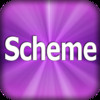Scheme Programming Language with Reference
Detailed App Info:
Application Description
A classic Scheme programming language for iPad, iPhone and iPod touch. Programming language is a perfect tool for studying, complex mathematical calculation, entertainment and many other useful tasks. The application is especially useful for learning the Scheme programming language. You have to buy compilations inside the application. Internet connection is required.
★★★★★ The great programming tool on the AppStore.
★★★★★ Your programming language for iOS is amazing!
☆ FEATURES ☆
✭ Compile and run your program.
✭ Text input before program run and text output.
✭ Online language reference and several program samples.
☆ COMMING SOON ☆
✭ Enhanced source code editor with syntax highlighting, line numbers, auto indentation, search and replace, undo history, color themes and additional keyboard.
✭ Import and export programs by iTunes or by email.
☆ LIMITATIONS ☆
✭ Internet connection is required to compile and run a program.
✭ Graphics, network, file system and real-time input are not supported.
✭ Maximum running time of a program is 15 seconds.
✭ Number of compilations per day is limited. Unlimited compilations will be available after update (at extra charge).
Thanks for using the application!
====================================
Scheme is one of the two main dialects of the programming language Lisp. Unlike Common Lisp, the other main dialect, Scheme follows a minimalist design philosophy specifying a small standard core with powerful tools for language extension. Its compactness and elegance have made it popular with educators, language designers, programmers, implementors, and hobbyists. The language's diverse appeal is seen as a strong point, though the consequently wide divergence between implementations is seen as one of the language's weak points.
Scheme was developed at the MIT AI Lab by Guy L. Steele and Gerald Jay Sussman who introduced it to the academic world via a series of memos, now referred to as the Lambda Papers, over the period 1975–1980. The Scheme language is standardized in the official IEEE standard, and a de facto standard called the Revisedn Report on the Algorithmic Language Scheme (RnRS). The most widely implemented standard is R5RS (1998), and a new standard R6RS was ratified in 2007.
Scheme was the first dialect of Lisp to choose lexical scope and the first to require implementations to perform tail-call optimization. It was also one of the first programming languages to support first-class continuations.
Scheme started as an attempt to understand Carl Hewitt's Actor model, for which purpose Steele and Sussman wrote a "tiny Lisp interpreter" using Maclisp and then "added mechanisms for creating actors and sending messages." Scheme was originally called "Schemer", in the tradition of other Lisp-derived languages like Planner or Conniver. The current name resulted from the authors' use of the ITS operating system, which limited filenames to two components of at most six characters each. Currently, "Schemer" is commonly used to refer to a Scheme programmer.
★★★★★ The great programming tool on the AppStore.
★★★★★ Your programming language for iOS is amazing!
☆ FEATURES ☆
✭ Compile and run your program.
✭ Text input before program run and text output.
✭ Online language reference and several program samples.
☆ COMMING SOON ☆
✭ Enhanced source code editor with syntax highlighting, line numbers, auto indentation, search and replace, undo history, color themes and additional keyboard.
✭ Import and export programs by iTunes or by email.
☆ LIMITATIONS ☆
✭ Internet connection is required to compile and run a program.
✭ Graphics, network, file system and real-time input are not supported.
✭ Maximum running time of a program is 15 seconds.
✭ Number of compilations per day is limited. Unlimited compilations will be available after update (at extra charge).
Thanks for using the application!
====================================
Scheme is one of the two main dialects of the programming language Lisp. Unlike Common Lisp, the other main dialect, Scheme follows a minimalist design philosophy specifying a small standard core with powerful tools for language extension. Its compactness and elegance have made it popular with educators, language designers, programmers, implementors, and hobbyists. The language's diverse appeal is seen as a strong point, though the consequently wide divergence between implementations is seen as one of the language's weak points.
Scheme was developed at the MIT AI Lab by Guy L. Steele and Gerald Jay Sussman who introduced it to the academic world via a series of memos, now referred to as the Lambda Papers, over the period 1975–1980. The Scheme language is standardized in the official IEEE standard, and a de facto standard called the Revisedn Report on the Algorithmic Language Scheme (RnRS). The most widely implemented standard is R5RS (1998), and a new standard R6RS was ratified in 2007.
Scheme was the first dialect of Lisp to choose lexical scope and the first to require implementations to perform tail-call optimization. It was also one of the first programming languages to support first-class continuations.
Scheme started as an attempt to understand Carl Hewitt's Actor model, for which purpose Steele and Sussman wrote a "tiny Lisp interpreter" using Maclisp and then "added mechanisms for creating actors and sending messages." Scheme was originally called "Schemer", in the tradition of other Lisp-derived languages like Planner or Conniver. The current name resulted from the authors' use of the ITS operating system, which limited filenames to two components of at most six characters each. Currently, "Schemer" is commonly used to refer to a Scheme programmer.
Requirements
Your mobile device must have at least 1.56 MB of space to download and install Scheme Programming Language with Reference app. Scheme Programming Language with Reference was updated to a new version. Purchase this version for $1.99
If you have any problems with installation or in-app purchase, found bugs, questions, comments about this application, you can visit the official website of Dmitry Kovba Megakey Trans at http://www.dmitry-kovba.com/.
Copyright © 2011 Dmitry Kovba





